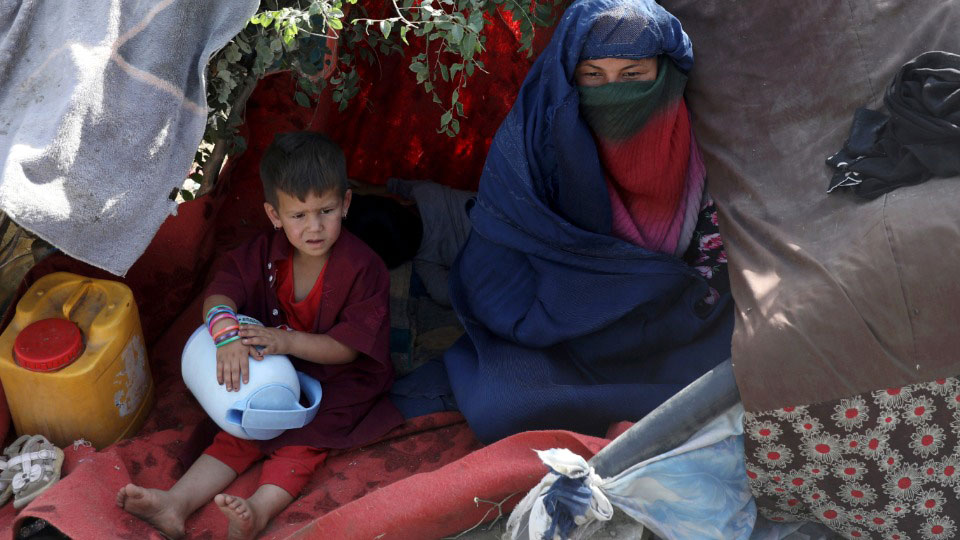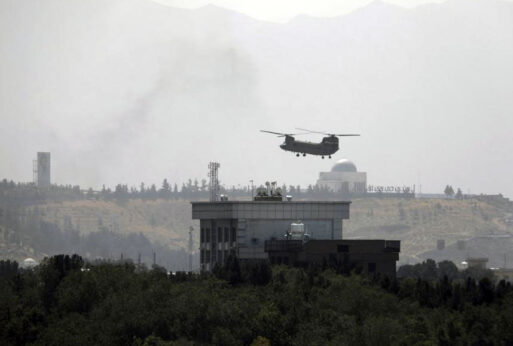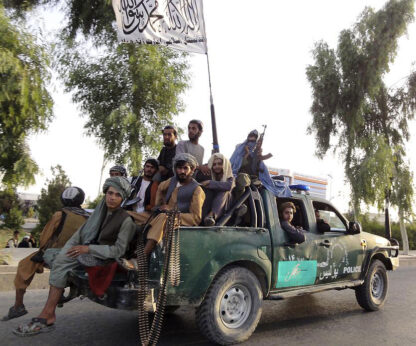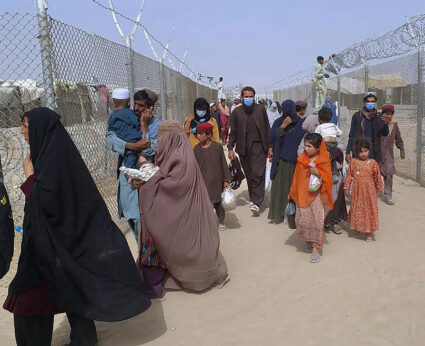
The U.S.’ war in Afghanistan—a war that never should have happened—is ending, finally. The chaotic imagery from Kabul flashed across the world’s televisions and smartphones over the last 24 hours has captured the final moments of U.S. imperialism’s longest military misadventure, the symbolic conclusion of an effort of conquest and control that was doomed from the start.
But for the people of Afghanistan, the stunning and sudden fall of their capital city this weekend to the religious terrorist forces of the Taliban marks—sadly—the opening of just the latest chapter in their long history of suffering as pawns of empire.
The Biden administration couldn’t have asked for a more embarrassing wrap-up to the Afghanistan war. A U.S. Air Force C-130 transport plane was filmed taking off from the Kabul airport even as desperate locals clung to their sides and landing gear, willing to try anything to escape the terror that looms. Three reportedly fell to their deaths as the aircraft lifted off. At the U.S. embassy, meanwhile, scenes of Saigon 1975 played out all over again as helicopters conducted a rushed evacuation of U.S. personnel.
Biden had set Sept. 11, 2021, as the deadline for withdrawal, just in time for the 20th anniversary of the 9/11 attacks that were used as justification for the war. Everyone knew it was just a matter of time before the Taliban would retake the country, but the U.S. military hoped to skip town before it happened and leave the Afghan government the task of negotiating its own demise.

According to reporting in the New York Times, top Biden advisors, who thought the administration of President Ashraf Ghani would hold out for a year or perhaps even a year-and-a-half, have been left stunned. Only last Thursday, sources in Washington were still saying Kabul had between 30 and 90 days before the capital would come under direct threat.
Instead, it was all over in just one weekend. The whole U.S. puppet state melted before the Taliban even arrived, and Biden was left having to announce the deployment of another 1,000 U.S. troops to assist in the hasty retreat.
Finger-pointing misses the point
In Washington, the partisan finger-pointing is underway in earnest, as is the dodging of accountability. “It’s Biden’s fault.” “No, it’s Trump’s fault.” “No, it was Obama who got us into this.” The accusations and recriminations are unceasing. The truth is that all of the above—and generations of U.S. presidents and foreign policy strategists before them—had a hand in creating and perpetuating Afghanistan’s tragedy.
The immediate origins of the war now ending are to be found of course in President George W. Bush’s 2001 invasion of Afghanistan, launched in the aftermath of Osama bin Laden’s strikes in New York and Washington on 9/11.
In the days immediately after the attacks, Bush took advantage of shock and fear to push for an immediate military response—even before the details of who had perpetrated the plane hijackings were known. Seven days after the World Trade Center towers fell, Congress voted to authorize military retaliation. In the Senate, the vote was 98 to 0; in the House, it was 420 to 1.
Rep. Barbara Lee was the lone opposing voice. She warned that the blanket authorization given to Bush was a recipe for endless war. Speaking on the House floor, she said:
“Our deepest fears now haunt us. Yet I am convinced that military action will not prevent further acts of international terrorism against the United States. Finally, we must be careful not to embark on an open-ended war with neither an exit strategy nor a focused target.”
Lee’s words were ignored. Less than a month later, U.S. bombs fell in Kabul—the opening act in Washington’s global “War on Terror.” Afghanistan and Iraq were envisioned as the lynchpins in a grand plan that would ensure U.S. control over the strategically important and resource-rich regions of Central Asia and the Middle East.
Since then, the war has killed more than 2,400 U.S. troops, wounded another 20,000, and burned through $2 trillion. Afghanistan has reportedly lost 164,436 people to fighting, though that number is surely a massive undercount.
Add in the other conflicts the U.S. has intervened in since Afghanistan and the invasions it launched after—Iraq, Syria, and more—and the cost, in both lives and resources, becomes truly staggering. Twenty years of war have meant as many as 800,000 deaths in the affected countries, nearly 15,000 U.S. troops and civilians killed, and as much as $8 trillion spent by the time borrowing and interest costs are calculated.
Pawns of empire

The rush in Kabul this weekend to paint over advertisements of women with uncovered faces before the Taliban arrived and the return of burqas to the streets of the city were disturbing indicators of the tragic and reactionary past that is about to be re-imposed on the people of Afghanistan. The failure of the United States’ neocolonial war will not mark the end of their oppression—just as the war of 2001 did not mark its beginning.
For them, the terror stretches much further back. In the 1800s, the country was a geopolitical prize in the struggle between imperial powers, eventually forced into a state of semi-dependency by the British. Throughout the 20th century, Afghanistan struggled to gain sovereignty over its own affairs and free itself from the bonds of religious fundamentalism.
From 1978 to 1992, Afghanistan was fighting to emerge from feudalism and build a modern democratic state under the leadership of a socialist-oriented government led by the People’s Democratic Party of Afghanistan. In retrospect, it’s now quite apparent that, despite the intense fighting of that time, these were the most promising years in Afghanistan’s recent history.
Supported by Soviet economic aid, great strides were made toward bringing education, medical care, decent housing, and sanitation to the people of this still largely rural country. Women were liberated to enter the workforce, get an education, and gain control over their own lives. New industries were being built in most of the big cities.
Situated in such a strategic location, however, the movement of Afghanistan toward the socialist camp was too much for U.S. imperialism to accept. Under Presidents Jimmy Carter, Ronald Reagan, and George H.W. Bush, the CIA funneled money and arms to local and imported reactionary forces opposed to the progressive government.
The U.S. hoped to not just destabilize Afghanistan but also inflict a heavy cost on the Soviet Union, which was providing for much of the country’s defense at the time. The Afghan people—like those of so many other countries—were pawns in the U.S.’ anti-communist Cold War strategy.
By the early 1990s, the U.S. mission had succeeded. The Soviet Union was gone, and eventually, the progressive government in Kabul was overthrown, replaced by the Taliban, a faction of the U.S.-backed militia forces. The fundamentalist guerrillas, and their terrorist allies in Al Qaeda, were supported and essentially helped to power by the CIA during those closing days of the Cold War.
To a certain degree, 9/11 was the blowback of those misguided anti-communist policies. And the 20-year war that followed was the disastrous price that the people of Afghanistan were forced to pay for the follies of U.S. empire.
The final withdrawal?
Now the tragedy of the U.S.’ long war in Afghanistan is reaching its nadir. With U.S. withdrawal a certainty, it took the Taliban less than two weeks to seize control of every major city in Afghanistan and march into the capital. The stunning pace of their takeover was perhaps the most dramatic proof of just how illegitimate the Afghan government propped up by the U.S was.
It commanded no loyalty from the masses of Afghan people. Even the Afghan National Army that the U.S. spent years building up and billions of dollars training dissolved essentially overnight. Everyone in the country knew the U.S. puppet state was finished, so why attach themselves to it any longer?
Biden inherited an unwinnable war, and, to his credit, he chose not to escalate it further. He could have opted for a stepped-up bombing offensive or sent more U.S. troops to delay the inevitable. Instead, he and his advisors decided to just get it over with and pull out now.

Still, the suddenness of the Afghan collapse puts his administration’s future foreign policy plans in jeopardy. And perhaps even more than the withdrawal from Vietnam over four decades ago, the retreat from Afghanistan represents a serious blow to the image of U.S. military dominance in the world.
The humiliation raises questions about the degree to which the U.S. may still attempt to influence Afghanistan and its affairs. Surely, the strategists in Washington will not want to leave the region to become a haven for terrorism once again, nor will they simply cede it to possible Russian or Chinese influence. So what shape will U.S. meddling in Central Asia take next?
There is little reason to believe that U.S. special forces and counter-terrorism specialists won’t continue to operate from time to time inside Afghanistan’s borders, plus Pakistan remains a base of operations as well. And in the age of drone wars, it’s not necessary for soldiers to be physically present in a country to impose U.S. power, anyway. Time will tell the degree to which the current drama truly represents Washington washing its hands of Afghanistan.
Meanwhile, the Islamist militia forces of the Taliban, which ruled Afghanistan in the late 1990s and harbored bin Laden, will now go about reconstructing their religious terror state. The prospects of peace and positive development in the country are zero. Women and girls face a grim future.
Without a doubt, Afghanistan will still be paying the price of U.S. invasion and occupation for years to come. And the possibilities for peaceful development and progressive change that appeared open to the country in the 1980s will recede further into the rear-view mirror of history.










